U.S. MAPLE
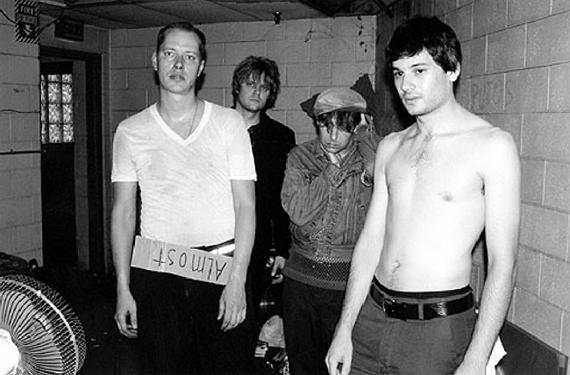 |
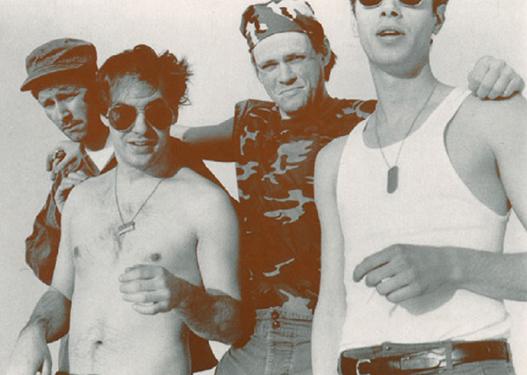 |
The Correct 'Yeah': U.S. Maple's Deconstruction of the Voice
by Dan Ruccia, Ph.D., Duke University
(June 2014)
Author's Note: This paper was original presented at 16th Annual City University of New York Graduate Students in Music (GSIM) Conference (January 2013). The theme of the conference was "Music and Philosophy." Most of the papers there were about classical music of various stripes; mine was the only one on rock. This paper is part of a larger project in which I analyze the connections between Derrida's thought and popular music. Thanks to Tony Ciarrocchi, Al Johnson, Mark Shippy, and the folks at Drag City Records for their help in making this project possible.
U.S. Maple was a Chicago-based rock group that existed from 1995 to 2007. During this time, they released five full-length albums and appeared on a few singles and compilations primarily on the Skin Graft and Drag City record labels, two labels known in the late 1990s for releasing noisy, experimental rock. The group consisted of singer Al Johnson, guitarists Mark Shippy and Todd Rittman, and drummer Pat Samson (who left the group in 2001 and was replaced by Adam Vida). Their music is related to what Marc Faris calls the "Chicago Sound," an offshoot or outgrowth of various punk and independent rock scenes that tends to use non-standard song forms, unusual meters, and diverse rhythmic layering sensibilities, recorded with a distinctive set of production values.i But U.S. Maple's sound was unconventional, even by the standards of the late ‘90's independent music scene. A typical U.S. Maple song could easily be heard to consist of shifting meters, randomly splattered guitar notes, chord injected with seemingly random dissonances, a vocalist who rasps and mutters more than he sings; and songs that refuse to coalesce into anything that might overtly resemble a pre-conceived form. As an example, listen to the beginning of the song "Through with 666" from their 1997 album Sang Phat Editor.
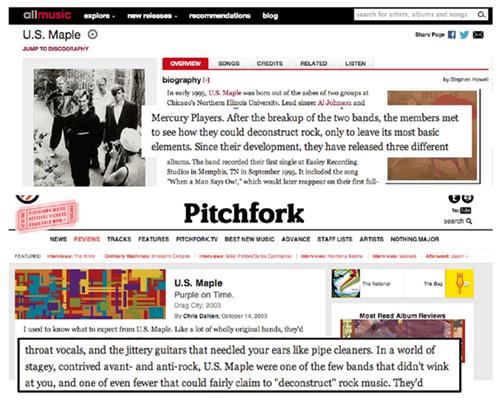
Despite its seeming outward incoherence, U.S. Maple's music caught on amongst a certain set of independent rock fans, a set who, naturally, sought a vocabulary to describe their experience of the music. By the late 1990's, a critical consensus emerged that the band was "deconstructing" rock, a consensus which is now ubiquitous—almost every reference to the band these days uses some variant of "deconstruction" as a descriptor. ii Singer Al Johnson expressed his disdain for the term "deconstruction" in an interview in Copper Press from 1999:
"The term ‘deconstruction' is a rock writer's handkerchief when describing U.S. Maple. You're really sweating when all you can come up with is that we are splicing music and nailing it together in the ‘wrong place.' We all grew up listening to the hard rock bands of the 70s, so we have this rock imprint stamped into our brains. We are reorganizing the rock and roll and adding, not subtracting, elements. We try to keep the things that we enjoyed the most about the past such as: Terror, mischief, elegance, and song. We rid ourselves of things like scummy chops."iii
This paper investigates the surprising parallels between U.S. Maple's notion of "reorganization" and Jacques Derrida's polyvalent corpus known as "deconstruction." I will focus, in particular, on how Al Johnson's vocals expand and critique the linguistic side of Derrida's theories through what Marcel Cobussen terms "deconstructions in music" (musical performances that act deconstructively on other musics). iv But before talking about U.S. Maple's music further, let's take a brief, incomplete tour of the relevant parts of Derrida's thinking.
"Deconstruction," to Derrida, begins with a critique of Saussure's theories of linguistics, and with a close reading of the process of signification. A phoneme or signifier only attains its identity by bumping up against that which it is not. Derrida is interested in the moment of differentiation between and within signifiers, the conceptual and temporal pause that separates "cat" from "bat;" the gap between the phoneme of the word "bat," the flying mammal, and the wooden implement used to hit a ball; the split between a Louisville Slugger and an aluminum bat; and so on. He terms this moment différance (spelled with an a), an untranslatable pun/neographism on the French verb différer (spelled with an e), which means some combination of to differ and to defer.v This pause is inherently unstable and thus can only be observed in a state of play, during which the ties connecting signifier to signified begin to weaken, implying that "the signified concept is never present in and of itself in sufficient presence that would refer only to itself,"vi as he writes in his 1968 essay "Différance." The deferral in différance allows for any residual meanings from those differing signifiers to remain behind in what Derrida terms the "trace."vii A signifier can be placed in any number of contexts, each of which affects that signifier's meaning; the play of différance suggests that all contexts, including newly defined ones, are always operative as connotative shadows. In short, Derrida argues that every supposedly unified signified actually contains a multiplicity of meanings which no one can entirely manage or control. Différance and the trace are perhaps the most basic aspects of Derrida's theories, but also the most fundamental. They are also, like much of Derrida's theories, silent, growing out of the arche-writing that comes before speech. Using them as I starting point, let's now turn to how U.S. Maple's vocals play with Derrida's ideas.
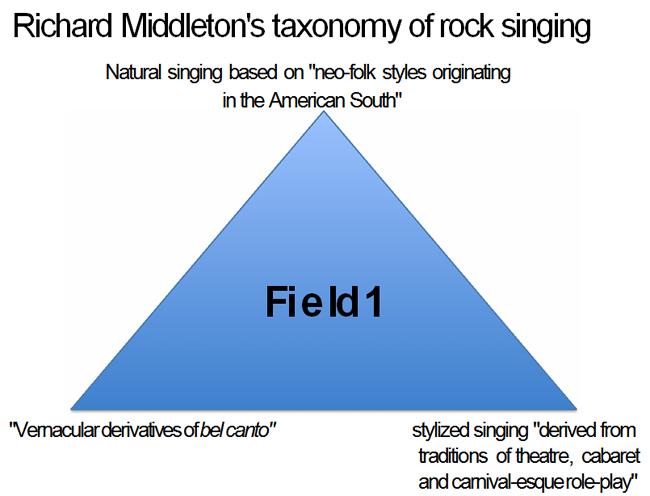
To help us understand rock singing in general and how Al Johnson's voice fits in, I'd like to spend a moment describing musicologist Richard Middleton's excellent taxonomy of rock singing, which maps the voice onto two triangular fields. viii The first addresses the sound of the voice; its corners represent "natural" singing (i.e. singing derived from "neo-folk styles originating in the American South"), "vernacular derivatives of bel canto," and "stylized" singing "derived from traditions of theatre, cabaret and carnival-esque role-play." This field encapsulates the complex interplay of authenticity and stylization, which Middleton emphasizes as an important driving force in rock vocal discourse.
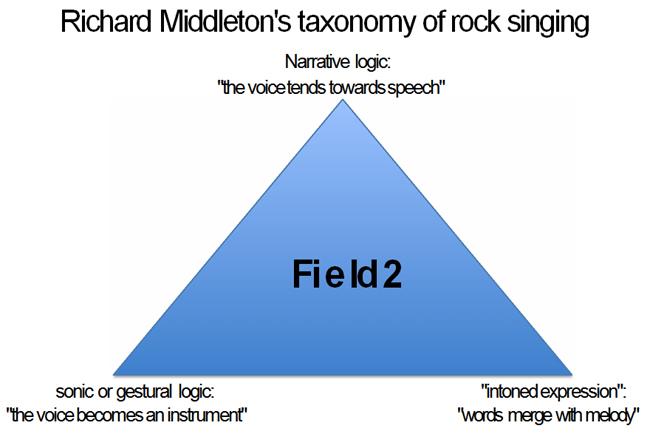
His second field relates a singer's words to their musical environment; its nodes are what he calls "narrative logic" (where "the voice tends towards speech"), "sonic or gestural logic" (things such as Little Richard's "A wop bop a loo bop, a lop bam boom"), and "intoned expression" (where "words merge with melody"). Questions of phrasing, diction, clarity, pitch, spontaneous utterance (what he terms the "para-linguistic dimension"), and rhythmic feel can be articulated differently in each field. Different genres of singing occupy certain conventionalized spaces in these fields, though singers often move freely through them over the course of a song or album.
Al Johnson's approach to singing tends toward an extremely stylized version of "naturalistic" singing, where the stylization disrupts various technical elements of singing. When he pays attention to pitch, his diction suffers; where words are clear and distinct, pitch often degrades. Power originates in the rasp instead of the scream. His most common locution is a choked "yeah" that evokes some mix of sexual pleasure and extreme agony. All of which combines to create characters who appears to lie beyond the normal field human interactions. Johnson's lyrics often sound like surrealist nonsense, overrun with paralinguistic sounds, growls, howls, yelps, et cetera. These utterances function as more than simple expressions of Middleton's "sonic" logic for Johnson; he strives to resituate them as "intoned expressions" through repetition and variation, and by actively imbuing them with precisely determined timbres and inflections.
Such an approach contains two simultaneous deconstructive gestures. The first, functions at the level of the phoneme or word. Phonemes gain identity through their differences, and Johnson works to undo the process of differentiation by de-emphasizing consonants, leaving only vowels as markers of difference. To demonstrate, here is an excerpt from near the beginning of the song "La Click" also from Sang Phat Editor.

As you can hear, Johnson has almost entirely eliminated the consonants from this simple, bluesy melody. My experience of this song was, for a long time, built around the way he continually shifts the timbres of vowels which were not tethered to any particular word. Johnson's voice was merely an embodied sound or some kind of muttered nonsense.

So you can imagine my surprise when Johnson, unprompted, sang this for me during a phone interview in early 2012: I was shocked: this song has actual words! And not just any words, but words of welcome, something which Johnson went out of his way to emphasize: "Have my hand then/I'm the company."
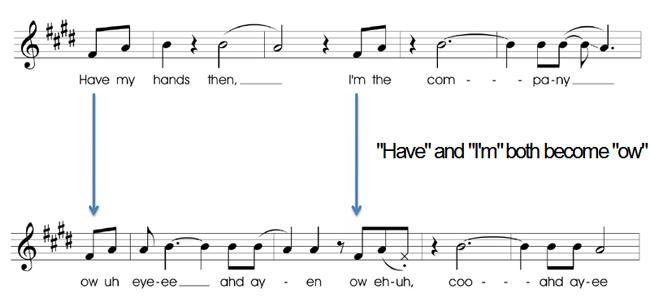
This suggests that Johnson is actually going a step farther than simply deemphasizing consonants in order to create nonsense: instead, he appears to begin with words and concepts, and intentionally undoes their physical construction in a way that makes audible the play of différance. In this line, "have" and "I'm" are aurally interchangeable, or, to paraphrase philosopher Alan Bass, they "defer differing, and differ from deferring."ix
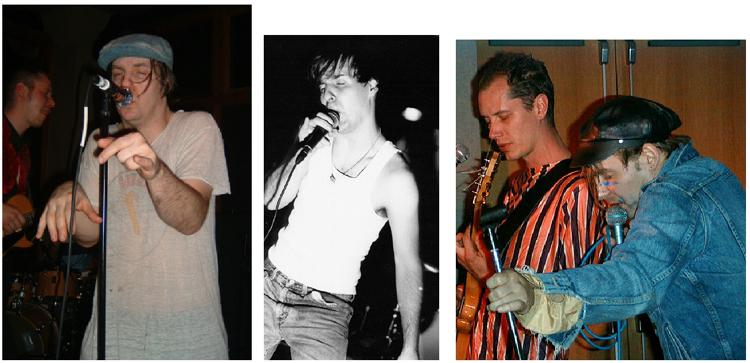
One way Johnson differentiates phonemes becomes what he terms "postures" which he describes as the silent, non-verbal communication that he attaches to the sounds he makes. When, as Johnson says, "you break language down to just a vowel, or a conjunction, an ‘and' or a ‘but' or an ‘or,' and you can attach to that a physical posture, it seems to culminate into a language."x I would argue, as well, that this idea could easily be expanded to cover the non-linguistic sonic parameters such as timbre and emphasis that Johnson also plays with.xi Johnson's decision to use vowels and conjunctions as the constitutive elements of his language is astute: since they mean so little on their own, they are able to absorb large amounts semiotic information from the "posture" Johnson attaches to them. The melodic phrase we just heard recurs multiple times through the song, and with each iteration, Johnson uses slightly different permutations of vowels and postures. He gives each vowel a distinct timbre which allows him to sustain an intentional and discernable sense of direction through the song. Through this process of shifting, he creates new combinations of phonemes that occasionally resemble words, but he denies them their conventional significations.xii
Johnson's second deconstructive gesture follows from the first: if the distinction between words or phonemes becomes purely one of timbre and attack, then it becomes possible to imagine other, non-linguistic sounds functioning in the same manner. Signification becomes permeable, and any sound that differs from any other sound can be perceived as a phoneme. This permeability implies a return to the split meaning of the ancient Greek term phone, which, according to philosopher Adriana Cavarero, was "applied to both human and animal voice, as well as to any other audible sound."xiii Such permeability creates an opening for the deconstruction of conventional instrumental roles: Johnson's voice is free to aurally encroach on the sound of the guitar or drums, and those instruments are able to become actively involved in the creation of phonetic meaning. At its most extreme, Johnson can be heard transferring the role of the voice from specifically phonetic signification to a more generalized phonation, converting the voice to a kind of embodied instrument in a process which moves well beyond Middleton's "sonic" field. Johnson does not appear to be selecting his sounds for their onomatopoeic effect; instead, he increasingly emphasizes what cultural theorist Mladen Dolar terms the acoustic "remainder which cannot be made a signifier or disappear in meaning."xiv For example, in "La Click," the guitar ostinato that accompanies Johnson in the previous example replaces the plosive consonants he omits, and the vowel sounds that Johnson emphasizes could be heard to evoke different guitar timbres. And the obsessive figurations in the guitar during the introduction could be seen as the guitar mirroring Johnson's vowel permutations. Other songs provide even stronger examples of this effect, but I want to keep the focus for now on "La Click." Johnson's voice is often mixed at an equal volume as the instruments, making it hierarchically equal to the rest of the ensemble, which Richard Middleton observes is unusual "in a genre where [the voice] is almost always texturally dominant."xv. All of this begs the question of where these floating signifiers refer, to what signifieds they attach, and what happens when they avoid pointing to any signifier, questions whose answers are inherently subjective and open. Given that openness, what Johnson says becomes far less interesting than how he says it, giving preference to what Levinas, as described by Adriana Cavarero, calls the "Saying" rather than the "Said."xvi
Both these deconstructive gestures, however, are predicated on the specific control Johnson has over his voice. As mentioned above, he tends to favor paralinguistic sounds, which are thought to be produced spontaneously, residing outside of the overall communicative structure of Middleton's "narrative" logic. If we locate narrative logic within the logocentrism of Western metaphysics, this category of vocal sounds is further removed from conventional syntax. As Cavarero notes,
"a phone that evades its semantic function becomes meaningless, irrational—indeed, when reduced to its semiotic function, at best it becomes animal. From the perspective of logos, the vocal ends up being funneled into a nostalgic regression toward nonsense, where the infant and the animal coincide. According to metaphysics, once the voice is taken away from language as a system of signification, it becomes meaningless."xvii
And yet, these kinds of sounds are often conceived as a prime locus for displays of authenticity, intensity, and ineffable emotions, or a generalized sense of the singer's personality, xviii in part, because they invoke the uniqueness of the individual speaker and the intimate connection between voice and body.
While not every song by U.S. Maple features incomprehensible vocals, Al Johnson's vocal delivery and word choice still seeks to obscure more meaning than they create. His focus is on crafting a personalized language inspired by a combination of the semantic fragments discussed above and various forms of slang,xix with the hope that it be legible as a language:
I was trying to express myself linguistically, and I wanted people to understand that I wasn't up there speaking in Spanish, or dressing up like ‘Cowboys and Indians,' or that this was something so totally foreign to me. I was very integrated into this language and understood it quite well.xx

"Logos—at least within the Aristotelian definition—is phone (substantive) semantike (adjective). Despite the grammar, the fundamental role falls to the semantic; and, precisely, to a semantic founded on the priority of the order of signifieds with respect to the signifiers. To the voice, therefore, goes the service role—it makes signifieds audible, it provides an acoustic robe for the mental work of the concept."xxiFinally, Johnson wants to reconstitute logos in the very sounds that logos traditionally exclude, to simulate meaning in meaninglessness.
As Johnson began to explore these alternate phonic spaces, he realized that he needed a system of notation so that he could replicate the arc of a song from one performance to the next, because, he says,
"I wanted to make sure there was variety. I wanted to make sure that the things I wanted to sound emphatic, and the words I wanted to sound like they were dying every single time I came out on stage but they were killing themselves in a different way every time [did]. But I needed to know where those parts were."xxiiHe describes this practice in this clip from a documentary by Tony Ciarrocchi about the making of their 2001 album Acre Thrills.xxiii He includes versions of his notation in the lyric sheets of Acre Thrills, amongst other albums. Notably, there is no lyric sheet for Sang Phat Editor.
Unsurprisingly, Johnson is incredibly concerned that his vocals are recorded precisely. He always records his vocals after the rest of the song is in place, and then he tends to record one phrase or word at a time, freeing him to draw out the particular character of each line as accurately as possible. In such an extended process, he could spend up to three hours in studio on a single song, sometimes, he says, going so far as to record vowels and consonants separately.xxiv Ciarrocchi captures this process Johnson in the studio recording the refrain of "Chang, You're Attractive."xxv This particular line ends with a "yeah," and Johnson is shown recording multiple different variations of that "yeah," searching for one that properly fits the context of the song. Later on, Johnson tells the sound engineer, "When you hear a wrong ‘yeah,' just [throw] it in my face," suggesting that a) there is such a thing as a "correct" "yeah" for any given context, and b) that a discerning listener could (should?) be able to differentiate and draw meaning from the difference between a correct and an incorrect "yeah." It also suggests his awareness of the role of the recording studio in the creation of his musical persona. This clip also shows Johnson contorting himself to embody the "postures" he is given to each "yeah." Note, as well, that each "posture" is somewhat different, matching the different inflections of each "yeah." All of these technique allows him to create the deconstructive effects discussed earlier, and further allows him to push at the frame of language to see how much strain it can sustain before collapsing entirely.
Underlying all of these deconstructions is the importance of iterability and intentionality. In order to create a language—even something that only resembles a language—phonemes must maintain recognizable patterns, and must appear in a way that seems predictable (that is the semantike in phone semantike). Between his notational system, his "postures," and his obsessive attention to phonic detail, Johnson is attempting to impose an artificial semantike with its own synthetic, yet comprehensible, logos onto his songs and listeners. He wants to repeatedly orchestrate a finite number of ways for words to kill themselves at carefully proscribed moments. He is Victor Frankenstein, stealing phonemes from a graveyard of verbal suicides and attempting to breathe a new, monstrous life into them (though hopefully without the same disastrous results).
The most commonly discussed moment for any U.S. Maple fan, one that I myself remember vividly,xxvi is the moment when they realize that all the sounds the band emits are intentional, are consciously placed. Such a moment occurs when the complicated interaction of verbal and sonic phonemes in U.S. Maple's songs begin to coalesce into a language for the listener. In Johnson's voice, that language emerges when Johnson successfully devises a logos out of paralinguistic sounds. It is this process of iteration that allows Johnson to cultivate and domesticate the "Saying" and a phone outside of the metaphysics of the semantike.
To sum up, Johnson is literally invoking a language which attains meaning specifically by not differing phonetically. Meaning and syntax emerge not from an act of phonetic difference but from inferred changes in inflection and emphasis. It is a language built entirely on a kind of phonic materiality which is irreducible to the conception of writing that is so critical to Derrida's argument in Of Grammatology, but which is still nonetheless fully situated within the play of différance. Johnson is re-sounding différance and the "trace," allowing us to hear what Derrida only lets us read.
FOOTNOTES:
i Marc Faris, "‘That Chicago Sound': Playing with (Local) Identity in Underground Rock," Popular Music and Society 27, No. 4 (2004): 429-454. The question of a Chicago "Sound," the idea that music from Chicago in general is rooted in a specific kind of sonic materiality, is quite intriguing and worthy of further discussion.
ii As a representative example, their biography on Amazon, written by Stephen Howell, says, "In early 1995, U.S. Maple was born out of the ashes of two groups at Chicago's Northern Illinois University. Lead singer Al Johnson and "high" guitarist Mark Shippy were in Shorty, while drummer Pat Samson and "low" guitarist Todd Rittman spent their time with the Mercury Players. After the breakup of the two bands, the members met to see how they could deconstruct rock, only to leave its most basic elements." Stephen Howell, "U.S. Maple Biography," Amazon, accessed February 28, 2013. http://www.amazon.com/U.S.-Maple/e/B000AQ2G1U/ref=ac_dpt_sa_bio. Interestingly, the word "deconstructionists" on the band's Wikipedia page was changed to "numismatists" in September 2012 by someone with a British ISP address. The Wikipedia Talk page also includes a discussion about the utility of the term "deconstructionist."
iii Al Johnson, quoted in Steve Brydges, "U.S. Maple: Ambience Chasers," Copper Press 2, (1999) (no page numbers).
iv Marcel Cobussen, Deconstruction in Music, (PhD diss., Erasmus University, 2001), "Deconstruction in Music." http://www.deconstruction-in-music.com.
v Derrida, "Différance," Margins of Philosophy, 1-27.
vi Ibid, 11.
vii Derrida, Of Grammatology, 62.
viii Richard Middleton, "Rock Singing." In The Cambridge Companion to Singing, edited by J. Potter (London: Cambridge University Press, 2000), 28-41
ix Alan Bass, trans., footnote 8 in Derrida, "Différance."
x Al Johnson, interview with author, March 19, 2012.
xi See Mladen Dolar's discussion of accent, intonation, and timbre in A Voice and Nothing More, 19-23.
xii The only vowel that's allowed to maintain its conventional meaning is the "hooooo" in the choruses, which seems to express excitement and overflowing energy which coincides with an arrival of the rest of the band.
xiii Adriana Cavarero, For More Than One Voice: Toward a Philosophy of Vocal Expression, trans. Paul A. Kottman, Stanford, California: Stanford University Press, 2005, 19.
xiv Dolar, A Voice and Nothing More, 20.
xv Middleton, "Rock Singing," 39.
xvi Cavarero, For More Than One Voice, 26-32.
xvii Ibid, 182.
xviii David Brackett, Interpreting Popular Music (Berkeley: University of California Press, 2000), 130. Frith, Performing Rites, 193. Walser, Running With the Devil, 45. Middleton, "Rock Singing" 34-35. Cavarero, For More Than One Voice, 182.
xix Johnson particularly mentions studying slang of the English working class, coal miners, and lower class African-Americans. Al Johnson, interview with author, March 19, 2012.
xx Ibid.
xxi "Logos—at least within the Aristotelian definition—is phone (substantive) semantike (adjective). Despite the grammar, the fundamental role falls to the semantic; and, precisely, to a semantic founded on the priority of the order of signifieds with respect to the signifiers. To the voice, therefore, goes the service role—it makes signifieds audible, it provides an acoustic robe for the mental work of the concept." Cavarero, For More Than One Voice, 35.
xxii Al Johnson, interview with author, March 19, 2012.
xxiii Hardeye Films, "U.S. Maple - Acre Thrills," YouTube, posted August 31, 2006. http://www.youtube.com/watch?v=loni6SVagbw.
xxiv I'm skeptical of this last assertion for any album after Sang Phat Editor. On later albums, individual words tend to have the kind of clarity and coherence that seems impossible using that process. And in the Acre Thrills documentary, we never see Johnson recording with quite that level of granularity.
xxv Hardeye Films, "U.S. Maple - Acre Thrills."
xxvi It came for me during a live performance of "La Click" when I began to recognize the song's underlying rhythmic grid and the way that the group oriented itself around it.